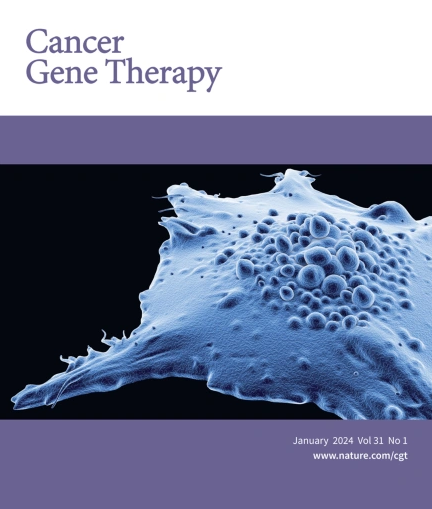新型赖氨酸特异性去甲基化酶 1 药物抑制剂作为胶质母细胞瘤的一种潜在疗法。
IF 4.8
3区 医学
Q1 BIOTECHNOLOGY & APPLIED MICROBIOLOGY
引用次数: 0
摘要
赖氨酸特异性去甲基化酶 1(LSD1/KDM1A)是一种关键的表观遗传学酶,可导致包括恶性胶质瘤在内的多种恶性肿瘤。LSD1 是一种依赖于黄素腺嘌呤二核苷酸的组蛋白去甲基化酶,专门针对组蛋白 H3 赖氨酸(K)4 单甲基化(me1)和双甲基化(me2)以及 H3K9me1/2 进行去甲基化。在此,我们报告了一种能有效穿透血脑屏障的 LSD 抑制剂 S2172 的研发情况。S2172 能有效抑制 LSD1 酶的活性,从而抑制神经胶质瘤干细胞(GSCs)体外细胞生长(平均半数最大抑制浓度(IC50)为 13.8 μM)和 GSC 正位异种移植小鼠模型体内细胞生长。用S2172治疗可显著降低GSC细胞中干性相关基因MYC和Nestin的表达。与此相一致,染色质免疫沉淀测序显示,H3K4me2/H3K4me3状态发生了显著的S2172依赖性改变。此外,我们还发现了 284 个经 S2172 处理后新获得的 H3K4me2 峰区,这些峰区包含在超级增强区中。S2172处理诱导的H3K4me2/H3K4me3状态的改变影响了与肿瘤发生相关的基因的表达。我们的数据表明,用S2172靶向LSD1可以为胶质母细胞瘤提供一种有前景的治疗方案,特别是由于靶向GSC群体。本文章由计算机程序翻译,如有差异,请以英文原文为准。

Novel pharmacologic inhibition of lysine-specific demethylase 1 as a potential therapeutic for glioblastoma
Lysine-specific demethylase 1 (LSD1/KDM1A) is a pivotal epigenetic enzyme that contributes to several malignancies including malignant glioma. LSD1 is a flavin adenine dinucleotide dependent histone demethylase that specifically targets histone H3 lysine (K) 4 mono- (me1) and di-methylation (me2) and H3K9me1/2 for demethylation. Herein we report the development of an LSD inhibitor, S2172, which efficiently penetrates the blood-brain barrier. S2172 effectively suppresses LSD1 enzymatic activity, resulting in the depletion of cell growth both in vitro in glioma stem cells (GSCs) (mean half-maximal inhibitory concentration (IC50) of 13.8 μM) and in vivo in a GSC orthotopic xenograft mouse model. Treatment with S2172 robustly reduced the expression of the stemness-related genes MYC and Nestin in GSC cells. Consistent with this, chromatin immunoprecipitation-sequencing revealed a significant S2172-dependent alteration in H3K4me2/H3K4me3 status. Furthermore, we identified 284 newly acquired H3K4me2 peak regions after S2172 treatment, which were encompassed within super-enhancer regions. The altered H3K4me2/H3K4me3 status induced by S2172 treatment affected the expression of genes related to tumorigenesis. Our data suggest that targeting LSD1 with S2172 could provide a promising treatment option for glioblastomas, particularly due to targeting of GSC populations.
求助全文
通过发布文献求助,成功后即可免费获取论文全文。
去求助
来源期刊

Cancer gene therapy
医学-生物工程与应用微生物
CiteScore
10.20
自引率
0.00%
发文量
150
审稿时长
4-8 weeks
期刊介绍:
Cancer Gene Therapy is the essential gene and cellular therapy resource for cancer researchers and clinicians, keeping readers up to date with the latest developments in gene and cellular therapies for cancer. The journal publishes original laboratory and clinical research papers, case reports and review articles. Publication topics include RNAi approaches, drug resistance, hematopoietic progenitor cell gene transfer, cancer stem cells, cellular therapies, homologous recombination, ribozyme technology, antisense technology, tumor immunotherapy and tumor suppressors, translational research, cancer therapy, gene delivery systems (viral and non-viral), anti-gene therapy (antisense, siRNA & ribozymes), apoptosis; mechanisms and therapies, vaccine development, immunology and immunotherapy, DNA synthesis and repair.
Cancer Gene Therapy publishes the results of laboratory investigations, preclinical studies, and clinical trials in the field of gene transfer/gene therapy and cellular therapies as applied to cancer research. Types of articles published include original research articles; case reports; brief communications; review articles in the main fields of drug resistance/sensitivity, gene therapy, cellular therapy, tumor suppressor and anti-oncogene therapy, cytokine/tumor immunotherapy, etc.; industry perspectives; and letters to the editor.
 求助内容:
求助内容: 应助结果提醒方式:
应助结果提醒方式:


